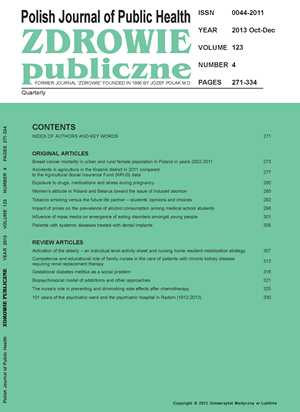Tobacco smoking versus the future life partner – students’ opinions and choices
DOI:
https://doi.org/10.12923/j.0044-2011/123-4/a.05Słowa kluczowe:
tobacco smoking, student, life partnerAbstrakt
Introduction. Diagnosing the motives of young people in the choice of life partners seems significant both for widely understood public health, and for forecasting the state of health of potential families.
Aim. The purpose of the survey was to get to know students’ opinions on health behaviour of their girlfriends or boyfriends and to determine whether the fact of smoking tobacco influences the choice of the candidate for a life partner.
Material and methods. The survey was part of a pilot diagnosis of behaviour, opinions and attitudes of students with regard to health, constituting a basis for the project “Health – Promoting University”. The surveyed group consisted of 207 students from three Lublin universities: Maria-Curie Skłodowska University (UMCS), Catholic University of Lublin (KUL) and Medical University of Lublin (MU).
Results. An anonymous diagnostic survey was applied, with the use of random sampling. Thirteen percent of the surveyed women are active smokers, of which the largest group consists of psychology students, and the percentage of smoking men is 29%. Sixteen percent of women and 10% men are ex-smokers. Women more frequently than men are passive smokers. Current tobacco smokers are mostly inhabitants of cities and they are students whose both parents smoke. As many as 1/3 of partners of the surveyed students smoke tobacco. The fact that the future life partner is a smoker is significant, but there were also students for whom the fact that their current or potential partner is or would be a smoker is of no significance.The students smoking tobacco attached to this aspect least importance, and the most importance was attached by students whose parents were both non-smokers.
Conclusions. The obtained results directly confirm the thesis that the choice of a life partner is connected with the assessment of his/her health behaviour (in this case – tobacco smoking) and can have an impact on the “health-related quality” of students’ relationships in the future and on the satisfaction of partners forming the relationships. The conducted research confirmed that among the surveyed group of students there is greater tolerance towards tobacco smoking by the partner in the case of persons who are themselves active smokers, and the necessity to undertake anti-smoking measures by universities in the form of support for students who are active and passive smokers
Bibliografia
1. Adamek AM, Anholcer A, Florek E, Adamek R. Ocena wpływu biernego narażenia kobiet na dym tytoniowy w czasie ciąży na masę urodzeniową i parametry życiowe noworodka. Ginekol Prakt. 2003;11(2):24-7.
2. Boratyn-Dubiel L, Binkowska-Bury M, Gugała B. Rozpowszechnienie palenia tytoniu wśród młodzieży akademickiej w Polsce. Zdr Publ. 2008;118(4):474-8.
3. Zdrowie 21. Zdrowie dla wszystkich do XXI wieku. Centrum Systemów Informacyjnych Ochrony Zdrowia. Warszawa-Kraków: Uniwersyteckie Wydawnictwo „Vesalius”; 2001. p. 66-70.
4. Woynarowska B. Siedliskowe podejście do zdrowia i jego realizacja w praktyce. In: JB. Karski (ed). Promocja zdrowia. Warszawa: Wyd. IGNIS; 1999. p. 367-9.
5. Postawy wobec palenia papierosów. Komunikat z badań, BS/36/2010. Centrum Badania Opinii Społecznej. Warszawa; 2010.
6. Siemińska A, Jassem JM, Uherek M, et al. Postawy wobec palenia tytoniu wśród studentów pierwszego roku medycyny. Pneumonol Alergol Pol. 2006;76:377-82.
7. Siemińska A, Jassem-Bobowicz JM, Uherek M, et al. Postawy wobec palenia tytoniu studentów I i IV roku medycyny z rocznika 2002-2008. Pneumonol Alergol Pol. 2009;77:371-9.
8. Kołłątaj W, Kołłątaj B, Karwat ID, Piecewicz-Szczęsna H. Postawy studentów Uniwersytetu Medycznego w Lublinie wobec palenia tytoniu. Prob Hig Epidemiol. 2010;9(3):495-500.
9. Łaszek M, Nowacka E, Szatko F. Negatywne wzorce zachowań studentów. Część I. Konsumpcja alkoholu i stosowanie substancji psycho¬aktywnych. Probl Hig Epidemiol. 2011;92(1):114-9.
10. Dutkiewicz S, Jara K. Rodzina w opinii młodzieży. Annales Uniwersitatis Mariae Curie-Skłodowska. Lublin-Polonia. Sectio D. 2004;LIX(Suppl.92):484-7.
11. Gulczyńska A, Jankowiak B. Poczucie koherencji studentów a jakość i trwałość ich związków partnerskich. Seksuolog Pol. 2007;5(2):66-70.
12. Kawczyńska-Butrym Z. Uczelnia Promująca Zdrowie. Założenia programu. Lublin: Wydawnictwo Uniwersytetu Marii Curie-Skłodowskiej; 1995.


